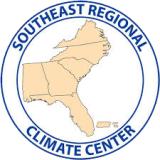Southeast Climate Monthly Webinar: September 24, 2024
“Feast or Famine” continues to be the theme this summer for the Southeast. Hurricane Francine brought beneficial moisture to parts of Alabama, while a persistent frontal boundary led to heavy rain across much of the Florida Peninsula. The rain from Potential Tropical Cyclone Eight contributed to catastrophic flash flooding across southeastern North Carolina. Some rainfall amounts may have exceeded the 1,000-year recurrence interval. Those interior areas that missed the precipitation continued to dry out and saw drought expand, including northern Alabama and Georgia, Tennessee, and South Carolina.
Looking ahead, Hurricane Helene is expected to rapidly intensify and become a major hurricane when it approaches the northeastern Gulf Coast on Thursday. The risk of impacts from devastating hurricane winds and life-threatening storm surges continues to increase along northern Florida and southern Georgia. Heavy rainfall and flooding is possible across the Southeast, southern Appalachians, and the Tennessee Valley later this week. Rainfall from this storm is expected to help remove drought conditions in certain areas, such as eastern Alabama, Georgia and eastern Tennessee.
Check out the recording below to hear more on Southeast climate conditions and a special presentation, "Fire Weather Portal for the Southeast,” from Corey Davis at the North Carolina State Climate Office at North Carolina State University. Another webinar on this expanded tool will be held on September 30 for fire managers and advanced users.
About This Webinar
The Southeast Climate monthly webinar series is hosted by the Southeast Regional Climate Center, the National Integrated Drought Information System (NIDIS), and the NOAA National Weather Service. These webinars provide the region with timely information on current and developing climate conditions such as drought, floods, and tropical storms, as well as climatic events like El Niño and La Niña. Speakers may also discuss the impacts of these conditions on topics such as agriculture production, water resources, wildfires, and ecosystems








